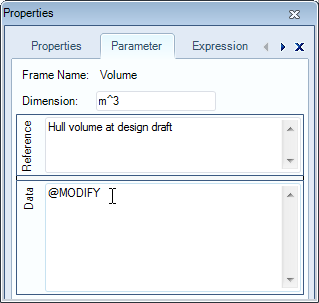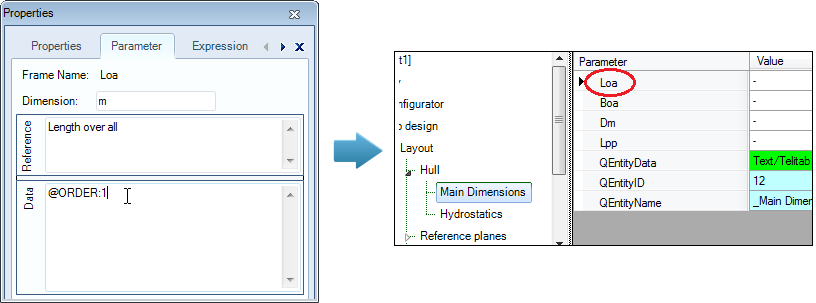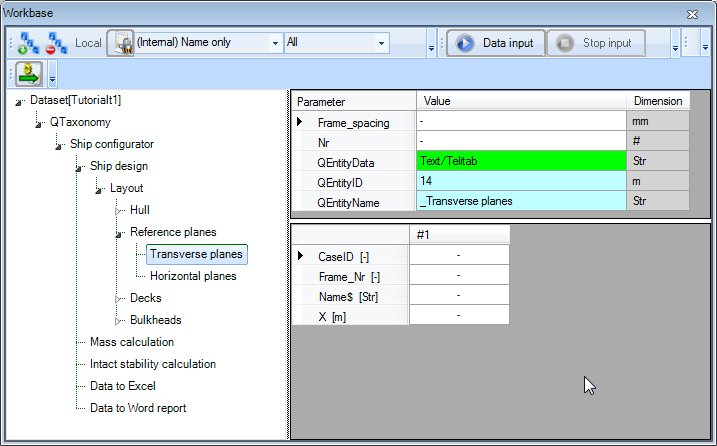Page History
...
For each plane the user has to define a position and a name.
- Create Add the following parameters in the the Knowledge Browser. Please note that “Name$” is a string parameter and not a value.:
Parameter name | Dimension | Determined by | Reference | In Class |
| [#] | VR: User only | Number of instances | General |
| [$Str] | VR: User only | Name of object | General |
| [-] | USR: User or system/equation | Case index | General |
| [-] | VR: User only | Frame number | General |
| [mm] | VR: User only | Frame spacing | Dimensions |
| [m] | VR: User only | X position, in longitudinal direction |
The parameters “Nr”, “Name$”, “Frame_Nr” and “Frame_spacing” will be determined by “VR: User only” (indicate “VR” in Slots & Properties of parameter).
Now drag and drop the parameters in “Transverse planes“: “Nr”, “Name$”, “CaseID”, “X”, “Frame_Nr” and “Frame_spacing”.
Figure 70 shows all parameters in Entity “Transverse planes”.
Figure 70: Parameters in Entity Transverse planes
...
Dimensions | ||||
Z | [m] | VR: User only | Z position, in vertical direction | Dimensions |
- Drag and drop parameter
ZinHorizontal planes. - Drag and drop the other parameters in
Transverse planes.
2 Enable users to modify calculated values
In the Domain Expert version of the tutorial, it was shown that a user can modify calculated values after they are determined by the system, if this is configured so the the Knowledge Engineer. You can enable this functionality by adding a @MODIFY attribute to the data slot of the parameter.
- Click on the parameter
Volumein the Knowledge Browser, select the Parameter tab of the Properties window and enter@MODIFYin the Data field.
...
3 Modify parameter display order
It can be desirable to influence the parameter display order in the Workbase list. Normally, Quaestor puts parameters in alphabetal order. An @ORDER attribute on a parameter defines the relative position of the parameter in the Workbase list. Define this position by: @ORDER:RelativePosition, in which RelativePosition is an integer. The @ORDER values need not be consecutive. Parameters are sorted on RelativePosition from low to high. Values with no @ORDER attribute are placed below parameters with @ORDER attributes.
...
- Click on the parameter
Loain the Knowledge Browser, select the Parameter tab of the Properties window and enter@ORDER:1in the Data field.
...
4 Define minimum and maximum values for parameters
Another interesting feature to assist the user, is to provide feedback about minimum and maximum input values. Moreover, you can make these boundaries into hard ranges in order to prevent the user from providing values that might cause faulty results.
...
- Add the following attributes to parameter
Cb:@MAXVAL:1.0,@MINVAL:0,@HARDRANGE
...
5 Show computed values during the dialogue
TODO is me nog niet duidelijk (ASR)
...
Figure 69: Entity "Hydrostatics" in taxonomy
5 Some more entities for the ship configurator
2.3.6.1 Let a parameter change the number of cases in an Entity
6 Have a parameter determine the number of cases in an entity
Parameter Nr will be used We will use parameter “Nr” to indicate the number of cases (columns) in an Entityentity.
Provide parameter “Nr” with the special attribute @NRINST in the (Data Slot of the parameter field of Parameter tab in Properties window). The @NRINST attribute tells Quaestor that attribute tells Quaestor that the value given/calculated for this parameter indicates the number of instances/cases in an object (in this case an Entity). TODO ??? (ASR)
It Furthermore it is useful to also provide “Nr” also with the attribute @INTEGER, see Figure 71. The @INTEGER attribute limits input or computed values of the parameter to integer values. If other than integer values are a non-integer value is either computed or provided, the system issues a warning and prompts for other input or for other new input of the related input.
Figure 71: Nr parameter, indicates number of instances within Entity
Moreover, for integer value you could also other parameter values that lead to this result. In addition, for this integer value you should change the number of decimal places to 0.
...
7 Make parameters multicase
Normally, the value of any single (constant) value parameter is placed displayed in the list view, see Figure 4.
The @MULTVAL attribute forces a single value parameter to present itself in the table of an Object/Entity. table form. The @MULTVAL attribute is used in parameters if you wish to obtain a table which includes all values of these parameters whether they are single (constant) values or not. Figure 17 in chapter 4.6 of the first part shows an example.See also the Domain Expert tutorial.
The following parameters need We want the following parameters to be shown in the table: “Name$”, “CaseID”, “Frame_Nr” and “X”. So you have to provide @MULTVAL attribute in the Data Slot of these four parameters. By doing this you can see the location of these parameters are moved from list view to table view ( you might have to force Quaestor to review the Workbase by switch between Entities). Please notice the differences between Figure 70 and Figure 72.
Figure 72: Parameters with @MULTVAL attribute in Entity Transverse planes
2.3.6.3 Relation for X position of transverse reference plane
...
have to set a @MULTVAL attribute on these. By doing this, you can see thethese parameters being moved from list view to table view (you might have to refresh Quaestor with Ctrl+U to redraw the Workbase).
8 Provide default values
- Create the following relation for parameter
Xin entityTransverse planesin the Workbase:
X = Frame_nr * (Frame_spacing/1000)
For each case, representing a transverse reference plane, this relation will be calculated. Parameter “Frame_spacing” does not contain have a @MULTVAL attribute, thus the value provided for “Frame_spacing” will be constant for each case.
2.3.6.4 Provide default values
It is possible to provide a proposed default value for “Frame_spacing” in the solution a parameter, that can be overruled by the user by simply providing this value for the parameter in the Entity. For example, type .
- Enter 700 in the
...
- Value cell of
Frame_spacing
...
- .
2.3.6.5 Use of ORCA() function to calculate numbers for each case: CaseID
...
The main goal is that we want to create the possibility for the user to define a table with a number of horizontal reference planes. For each plane the user has to define a position and a name.
- First create the following parameter in the Knowledge Browser.
...
Parameter name
...
Dimension
...
Reference
...
Z
...
[m]
...
Provide parameter “Z” also with an attribute @MULTVAL in the Data Slot of the parameter.
- Next include the following parameters in Entity “Horizontal planes“: “Nr”, “Name$”, “CaseID”, “Z”, “QEntityData”, “QEntityDoc”and “QEntityRef”.
- Parameters “Nr”, “Name$” and “Z” will be requested to the user (so all are VR parameters). Instantiate the parameters “Nr” and “Name$” in Entity “Horizontal planes” and provide for both parameters a @WBNAME attribute to define a presentation name for the user.
- Create the following relation CaseID = ORCA(1)
- To show computed values during a dialogue write “@SHOW” behind “QEntityData”.
- Add picture “reference_planes.bmp” as Binary to “QEntityDoc”.
- Assign the following text for “QEntityRef”; “Define number of horizontal reference planes”
...






